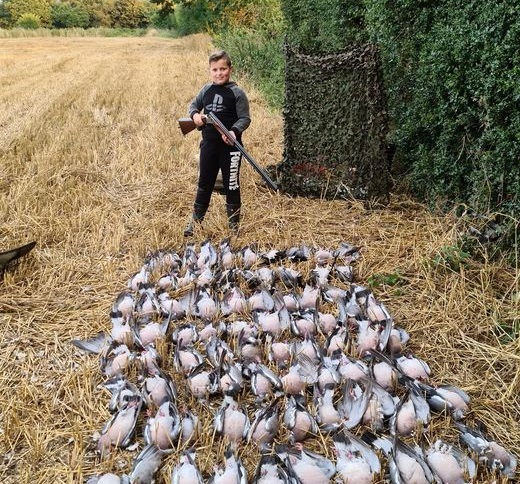The woodpigeon
The woodpigeon, Columba palumbus, has been native to Great Britain for centuries, its cousin in mainland Europe is migratory but we have the only sedentary population of the species that exists. We probably have as many as 15-20 million birds in the UK.
The population is healthy, the bird breeds at least twice, and in good warm summers three times, a year and they lay two eggs at a time. It has been guesstimated that we shoot around a third of this increasing population and more than 200,000 people shoot woodpigeon in the UK every year.
The woodpigeon is easy to recognise; a delicate grey overall with white wing bars and, in the adults, a white neck band. The underside of the body is a rich mixture of colours from pink to mauve. A bright yellow eye, a wingspan of just over two feet and an extraordinary capacity for aerobatics which can leave the decoyer with two empty cartridges and nothing in the bag more often than you would believe. Our bird weighs around 20 ounces and is capable of flying more than 50 miles an hour in level flight.
By the way, if the bird you are aiming at has no white wing bars don’t even attempt to shoot it, it is most likely a stock dove and protected under the 1981 Wildlife and Countryside Act.
The woodpigeon (Columba palumbus) is both the UK’s major agricultural bird pest and one of the most popular species providing sporting shooting. It is legal to shoot the bird throughout the year under the current general licence arrangements. The woodpigeon produces high-quality meat for all to enjoy.
High standards underpin public and political support for shooting, now and in the future.
The code provides advice at two levels:
Advice that must be followed in order to achieve Best Practice – unless otherwise stated the term ‘must’ only applies to meeting the standards set by this Code of Practice and does not refer to a legal obligation.
Advice that should be followed in order to achieve Best Practice – any deviation from which would need justification.
The following Golden Rules apply:
1. You must ensure that you have established safe arcs of fire.
2. You must clearly identify the quarry before shooting.
3. It is your responsibility to ensure you abide by the law.
4. Always have respect for the countryside, consideration for others and due regard to health and safety.
2. WOODPIGEON SHOOTING
Decoying
Woodpigeon decoying is the art of building a hide on a field where pigeons are feeding and using artificial or dead bird decoys to attract pigeons to within effective shotgun range (20 to 35 yards). To achieve the best results requires reconnaissance, considerable patience and knowledge of field craft.
Hides may be built using camouflage nets, straw bales or natural cover. When using bales remember to ask the farmer’s permission before you move them and always replace them after you have finished shooting. Natural hides are made with materials found on the farm and should be dismantled at the end of the shooting day. Do not cut into hedgerows or otherwise damage the farmer’s property without permission. The hide should be large enough to accommodate the shooter, the dog and equipment, and should have as level a floor as possible leaving sufficient room to shoot safely.
Flighting
Shooting pigeons on flight lines is very popular. Reconnaissance will determine the line of flight allowing Guns to stand concealed on the edges of woods or in hedgerows and shoot passing birds without the aid of decoys. Be ready to move if flight lines change.
Roost shooting
Normally, during the late winter, Guns position themselves before dusk in woods where pigeons are known to roost and wait for the birds to return from their day’s feeding. Mixed woods of conifers and hardwoods are the most popular and pigeon droppings under the trees will show the best places to stand. As it will be almost dark before the shoot ends it is important to retrieve wounded birds immediately after they are shot.
“The wildlife of today is not ours to dispose of as we please. We have it in trust. We must account for it to those who come after.” – KING GEORGE VI
